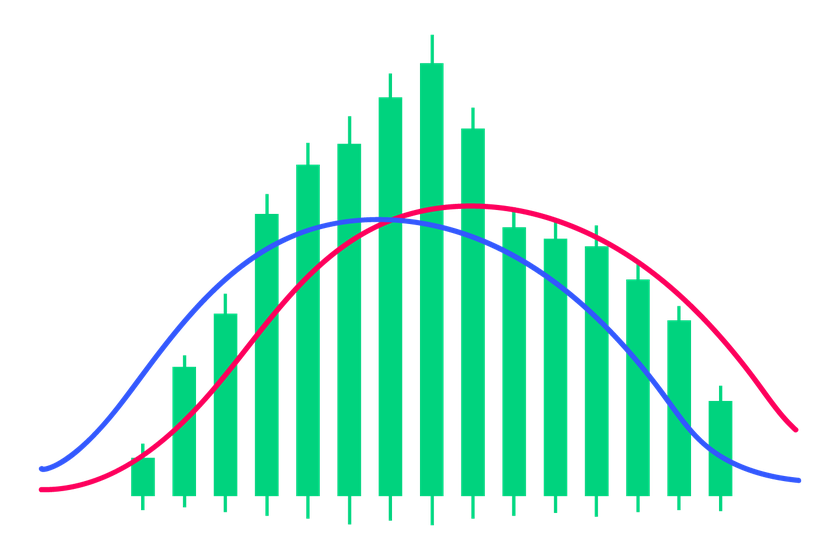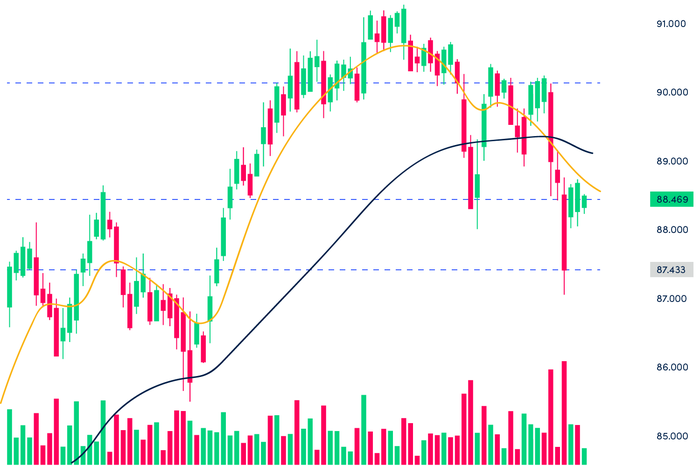Learn the basics of technical analysis
Get to know the basics of technical analysis in trading the markets and use them while constructing your own trading strategy.
Get to know the basics of technical analysis in trading the markets and use them while constructing your own trading strategy.

In this article you will learn:
- What is technical analysis?
- How it is different from fundamental analysis
- Finding the right entry and exit points
What is technical analysis in trading?
Technical analysis for trading studies the price of an asset such as a forex pair using historical price charts and market statistics. It is rooted in the notion that if you can identify previous market patterns, you can form a fairly accurate prediction of future price action. One way of looking at technical analysis is to see it as the study of change in supply and demand as reflected in the market price movements of an asset or security.
Technical analysis can be used on any security you are looking at, including forex and cryptocurrencies, i.e, forex technical analysis or crypto technical analysis etc.
Technical analysis versus fundamental analysis
When traders talk about technical analysis, they are referring to the study of price and volume as they see it on a chart. Unlike traders who ‘trade the fundamentals’ such as the news, traders who ‘trade the technicals’ prefer to study price patterns over time periods ranging from a few seconds to a month. This is usually done using a variety of tools, such as indicators, to understand which way price is moving in any given market.
Some traders use only technical analysis, while others prefer to rely on fundamental analysis when planning their trades. Sometimes these two trading approaches can be combined to create one robust trading strategy.
For example, a combination of technical and fundamental analysis could be used to better understand the correlation between oil and currency prices. This could help traders better understand the markets when taking a position on oil prices. For example, countries that produce and export oil in high volumes are dependent on high prices for oil. For them, a sharp drop in the price of oil would typically impact the value of the country’s currency.
Canada is a significant producer of oil and other energy products. In April of 2020, the Canadian dollar tumbled significantly against the US dollar, as the oil markets fell dramatically. Traders aware of the connection between oil and USD/CAD could have taken advantage of the Canadian Dollar’s recovery in the weeks following oil’s recovery by going short this pair until they saw a break in the trend.
Another example of being cautious and taking fundamental aspects into consideration, supply and demand in particular, was when the SARS-Cov-2 pandemic hit. The fear of coronavirus spreading and lockdowns being put in place around the world caused oil demand to drop sharply. U.S. warehouses were full of oil, there was nowhere to store it, and nobody wanted to buy it. The date of the May West Texas Intermediate Crude Oil contracts expiry was approaching, causing the price to be quoted negative for the first time in history, dropping from $18 a barrel to around -$37 a barrel.
Taking your first step in technical analysis
The first steps in technical analysis start with the chart to see what price is doing, as seen across the higher timeframes.
- Is there a trend (up or down) or is price stuck in a range?
- Where are the strongest areas of support and resistance?
As a technical analyst, even before you plan a trade you could first mark out the price zones where a price has found support and resistance repeatedly over time. The more often a price bounces off a support line, the stronger that area of support becomes. The same is true of an area of resistance. Even if you only think to trade the lower timeframes, it is good practice to be aware of these zones dating back months and even years. This is because history and, in this case price history, has a way of repeating itself.
Tools used by technical analysts
In general, technical analysts will also want to study a chart using their favorite tools, such as moving averages, volume and momentum indicators, and oscillators. All these tools are designed to give you a better idea of where and how fast a price is moving and help you take ‘high probability’ trades.
Finding good entry and exit points for a trade
Having marked out support and resistance areas on your chart with, say, the rectangle tool, (which you can find in your drawing tools on the chart), your next step could be to look for an opportune area where you can enter a trade. Some trade strategies may look to buy the dips and sell the tops, but the question is, which dips and which tops?
Broadly speaking, if you buy at the first bottom you see or sell as a price falls from the top, you risk being stopped out if price forms double bottoms (the second bottom often being lower than the first) and double tops, with the second top being higher than the one you wanted to trade. This is why experienced traders look for confirmation before placing an order.
Price often moves in zig zags - for every move up, there may be a move in the opposite direction, sometimes by as little as 25%, others by a full 100% or more. Let’s say you’ve identified a potential price reversal to the upside and you plan to open a buy order in the hope of getting a long run up (in the opposite direction). You’ve learned that traders ‘buy the dip’, so here’s your dip.
However, the experienced trader has learned to wait and see if an upward trend can properly form and then make a play. This is because many reversals fail. In the case of a single bottom, price can climb and then drop down the same day, often falling further than the previous major low, to form a double bottom, before resuming the climb up. The same is true of tops, especially at the end of a strong trend up: a top may form, break to the downside, then reverse sharply up, knocking out the stop losses of inexperienced traders before resuming its path down.
Develop your technical skills with the traders tools section of our website, which offers information about the different kinds of tools available on our trading platforms.
Key takeaways
- Traders use technical analysis to evaluate investments and identify trading opportunities
- Technical analysis analyzes statistical trends gathered from trading activity, such as price movement and volume
- Technical analysts use price data from different timeframes of an asset to construct high probability trades
- Key support and resistance zones are mapped on a chart to better identify good entry and exit points
- Technical analysis tools include moving averages, indicators, oscillators and drawing tools such as trend lines, triangles and pitchforks
- Many traders use fundamental analysis together with technical analysis to plan their trades, especially longer term trades
Whether you are a technical or fundamental trader, you can take advantage of our trading education. Our free webinars, workshops and how-to videos can help you learn the basics of leverage trading for free. With a live or demo account, you can start to implement some of the trading strategies that we feature in our learn section.
Past performance is not indicative of future results. This article and its contents are for educational purposes only and should not be considered trading advice.
Forex trading is high risk. Losses may exceed deposits.
OANDA CORPORATION IS A MEMBER OF NFA AND IS SUBJECT TO NFA'S REGULATORY OVERSIGHT AND EXAMINATIONS. HOWEVER, YOU SHOULD BE AWARE THAT NFA DOES NOT HAVE REGULATORY OVERSIGHT AUTHORITY OVER UNDERLYING OR SPOT VIRTUAL CURRENCY PRODUCTS OR TRANSACTIONS OR VIRTUAL CURRENCY EXCHANGES, CUSTODIANS OR MARKETS.
Difference between leveraged and other forms of financial trading.
expand_less expand_moreUse fundamental analysis to your advantage.
expand_less expand_moreHow is technical analysis different from fundamental analysis?
expand_less expand_moreHow to build a robust trading strategy using indicators and oscillators.
expand_less expand_more